Michael A. Hedderich
Evaluating Robustness of Large Language Models Against Multilingual Typographical Errors
Oct 10, 2025Abstract:Large language models (LLMs) are increasingly deployed in multilingual, real-world applications with user inputs -- naturally introducing typographical errors (typos). Yet most benchmarks assume clean input, leaving the robustness of LLMs to typos across languages largely underexplored. To address this gap, we introduce MulTypo, a multilingual typo generation algorithm that simulates human-like errors based on language-specific keyboard layouts and typing behavior. We evaluate 18 open-source LLMs across three model families and five downstream tasks spanning language inference, multi-choice question answering, mathematical reasoning, and machine translation tasks. Our results show that typos consistently degrade performance, particularly in generative tasks and those requiring reasoning -- while the natural language inference task is comparatively more robust. Instruction tuning improves clean-input performance but may increase brittleness under noise. We also observe language-dependent robustness: high-resource languages are generally more robust than low-resource ones, and translation from English is more robust than translation into English. Our findings underscore the need for noise-aware training and multilingual robustness evaluation. We make our code and data publicly available.
A Comprehensive Evaluation of Multilingual Chain-of-Thought Reasoning: Performance, Consistency, and Faithfulness Across Languages
Oct 10, 2025Abstract:Large reasoning models (LRMs) increasingly rely on step-by-step Chain-of-Thought (CoT) reasoning to improve task performance, particularly in high-resource languages such as English. While recent work has examined final-answer accuracy in multilingual settings, the thinking traces themselves, i.e., the intermediate steps that lead to the final answer, remain underexplored. In this paper, we present the first comprehensive study of multilingual CoT reasoning, evaluating three key dimensions: performance, consistency, and faithfulness. We begin by measuring language compliance, answer accuracy, and answer consistency when LRMs are explicitly instructed or prompt-hacked to think in a target language, revealing strong language preferences and divergent performance across languages. Next, we assess crosslingual consistency of thinking traces by interchanging them between languages. We find that the quality and effectiveness of thinking traces vary substantially depending on the prompt language. Finally, we adapt perturbation-based techniques -- i.e., truncation and error injection -- to probe the faithfulness of thinking traces across languages, showing that models rely on traces to varying degrees. We release our code and data to support future research.
Charting the Landscape of African NLP: Mapping Progress and Shaping the Road Ahead
May 28, 2025Abstract:With over 2,000 languages and potentially millions of speakers, Africa represents one of the richest linguistic regions in the world. Yet, this diversity is scarcely reflected in state-of-the-art natural language processing (NLP) systems and large language models (LLMs), which predominantly support a narrow set of high-resource languages. This exclusion not only limits the reach and utility of modern NLP technologies but also risks widening the digital divide across linguistic communities. Nevertheless, NLP research on African languages is active and growing. In recent years, there has been a surge of interest in this area, driven by several factors-including the creation of multilingual language resources, the rise of community-led initiatives, and increased support through funding programs. In this survey, we analyze 734 research papers on NLP for African languages published over the past five years, offering a comprehensive overview of recent progress across core tasks. We identify key trends shaping the field and conclude by outlining promising directions to foster more inclusive and sustainable NLP research for African languages.
Do We Know What LLMs Don't Know? A Study of Consistency in Knowledge Probing
May 27, 2025Abstract:The reliability of large language models (LLMs) is greatly compromised by their tendency to hallucinate, underscoring the need for precise identification of knowledge gaps within LLMs. Various methods for probing such gaps exist, ranging from calibration-based to prompting-based methods. To evaluate these probing methods, in this paper, we propose a new process based on using input variations and quantitative metrics. Through this, we expose two dimensions of inconsistency in knowledge gap probing. (1) Intra-method inconsistency: Minimal non-semantic perturbations in prompts lead to considerable variance in detected knowledge gaps within the same probing method; e.g., the simple variation of shuffling answer options can decrease agreement to around 40%. (2) Cross-method inconsistency: Probing methods contradict each other on whether a model knows the answer. Methods are highly inconsistent -- with decision consistency across methods being as low as 7% -- even though the model, dataset, and prompt are all the same. These findings challenge existing probing methods and highlight the urgent need for perturbation-robust probing frameworks.
MAKIEval: A Multilingual Automatic WiKidata-based Framework for Cultural Awareness Evaluation for LLMs
May 27, 2025Abstract:Large language models (LLMs) are used globally across many languages, but their English-centric pretraining raises concerns about cross-lingual disparities for cultural awareness, often resulting in biased outputs. However, comprehensive multilingual evaluation remains challenging due to limited benchmarks and questionable translation quality. To better assess these disparities, we introduce MAKIEval, an automatic multilingual framework for evaluating cultural awareness in LLMs across languages, regions, and topics. MAKIEval evaluates open-ended text generation, capturing how models express culturally grounded knowledge in natural language. Leveraging Wikidata's multilingual structure as a cross-lingual anchor, it automatically identifies cultural entities in model outputs and links them to structured knowledge, enabling scalable, language-agnostic evaluation without manual annotation or translation. We then introduce four metrics that capture complementary dimensions of cultural awareness: granularity, diversity, cultural specificity, and consensus across languages. We assess 7 LLMs developed from different parts of the world, encompassing both open-source and proprietary systems, across 13 languages, 19 countries and regions, and 6 culturally salient topics (e.g., food, clothing). Notably, we find that models tend to exhibit stronger cultural awareness in English, suggesting that English prompts more effectively activate culturally grounded knowledge. We publicly release our code and data.
Grokking ExPLAIND: Unifying Model, Data, and Training Attribution to Study Model Behavior
May 26, 2025Abstract:Post-hoc interpretability methods typically attribute a model's behavior to its components, data, or training trajectory in isolation. This leads to explanations that lack a unified view and may miss key interactions. While combining existing methods or applying them at different training stages offers broader insights, these approaches usually lack theoretical support. In this work, we present ExPLAIND, a unified framework that integrates all three perspectives. First, we generalize recent work on gradient path kernels, which reformulate models trained by gradient descent as a kernel machine, to more realistic training settings. Empirically, we find that both a CNN and a Transformer model are replicated accurately by this reformulation. Second, we derive novel parameter- and step-wise influence scores from the kernel feature maps. We show their effectiveness in parameter pruning that is comparable to existing methods, reinforcing their value for model component attribution. Finally, jointly interpreting model components and data over the training process, we leverage ExPLAIND to analyze a Transformer that exhibits Grokking. Among other things, our findings support previously proposed stages of Grokking, while refining the final phase as one of alignment of input embeddings and final layers around a representation pipeline learned after the memorization phase. Overall, ExPLAIND provides a theoretically grounded, unified framework to interpret model behavior and training dynamics.
What's the Difference? Supporting Users in Identifying the Effects of Prompt and Model Changes Through Token Patterns
Apr 22, 2025Abstract:Prompt engineering for large language models is challenging, as even small prompt perturbations or model changes can significantly impact the generated output texts. Existing evaluation methods, either automated metrics or human evaluation, have limitations, such as providing limited insights or being labor-intensive. We propose Spotlight, a new approach that combines both automation and human analysis. Based on data mining techniques, we automatically distinguish between random (decoding) variations and systematic differences in language model outputs. This process provides token patterns that describe the systematic differences and guide the user in manually analyzing the effects of their prompt and model changes efficiently. We create three benchmarks to quantitatively test the reliability of token pattern extraction methods and demonstrate that our approach provides new insights into established prompt data. From a human-centric perspective, through demonstration studies and a user study, we show that our token pattern approach helps users understand the systematic differences of language model outputs, and we are able to discover relevant differences caused by prompt and model changes (e.g. related to gender or culture), thus supporting the prompt engineering process and human-centric model behavior research.
Probing LLMs for Multilingual Discourse Generalization Through a Unified Label Set
Mar 13, 2025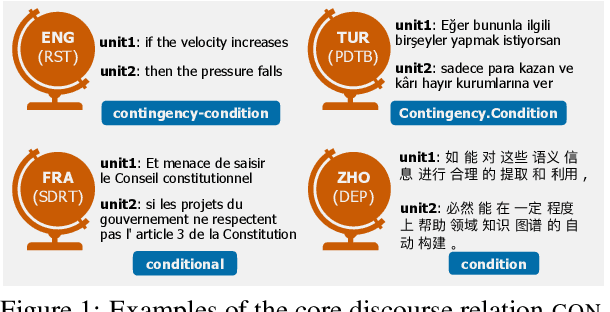
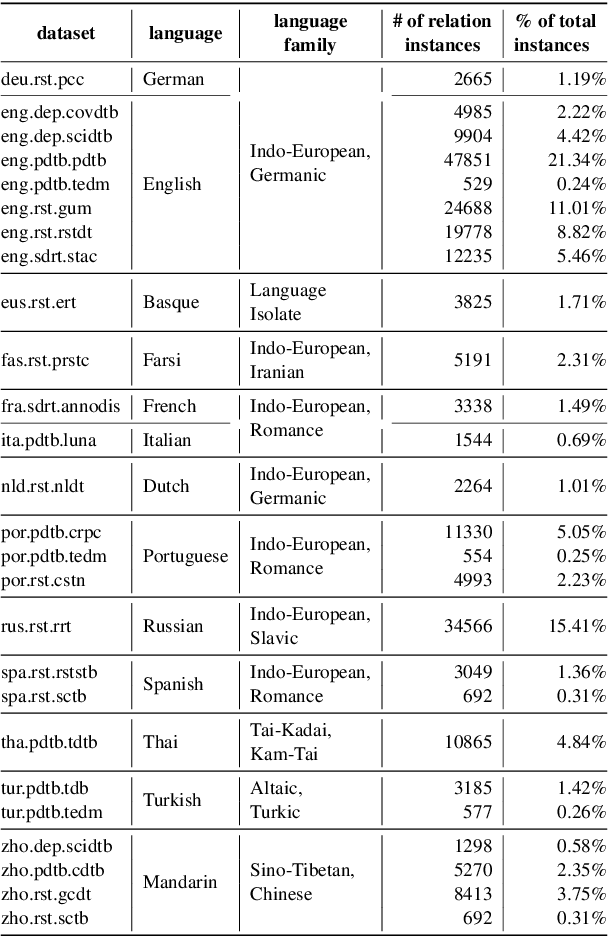
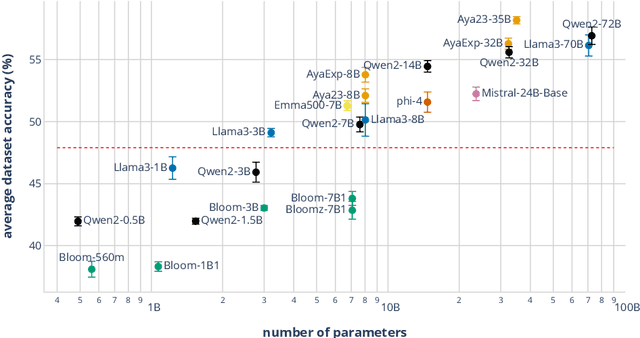
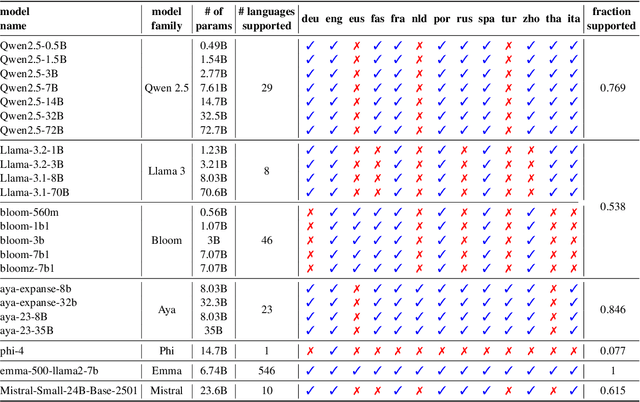
Abstract:Discourse understanding is essential for many NLP tasks, yet most existing work remains constrained by framework-dependent discourse representations. This work investigates whether large language models (LLMs) capture discourse knowledge that generalizes across languages and frameworks. We address this question along two dimensions: (1) developing a unified discourse relation label set to facilitate cross-lingual and cross-framework discourse analysis, and (2) probing LLMs to assess whether they encode generalizable discourse abstractions. Using multilingual discourse relation classification as a testbed, we examine a comprehensive set of 23 LLMs of varying sizes and multilingual capabilities. Our results show that LLMs, especially those with multilingual training corpora, can generalize discourse information across languages and frameworks. Further layer-wise analyses reveal that language generalization at the discourse level is most salient in the intermediate layers. Lastly, our error analysis provides an account of challenging relation classes.
Semantic Component Analysis: Discovering Patterns in Short Texts Beyond Topics
Oct 28, 2024



Abstract:Topic modeling is a key method in text analysis, but existing approaches are limited by assuming one topic per document or fail to scale efficiently for large, noisy datasets of short texts. We introduce Semantic Component Analysis (SCA), a novel topic modeling technique that overcomes these limitations by discovering multiple, nuanced semantic components beyond a single topic in short texts which we accomplish by introducing a decomposition step to the clustering-based topic modeling framework. Evaluated on multiple Twitter datasets, SCA matches the state-of-the-art method BERTopic in coherence and diversity, while uncovering at least double the semantic components and maintaining a noise rate close to zero while staying scalable and effective across languages, including an underrepresented one.
Understanding When Tree of Thoughts Succeeds: Larger Models Excel in Generation, Not Discrimination
Oct 24, 2024
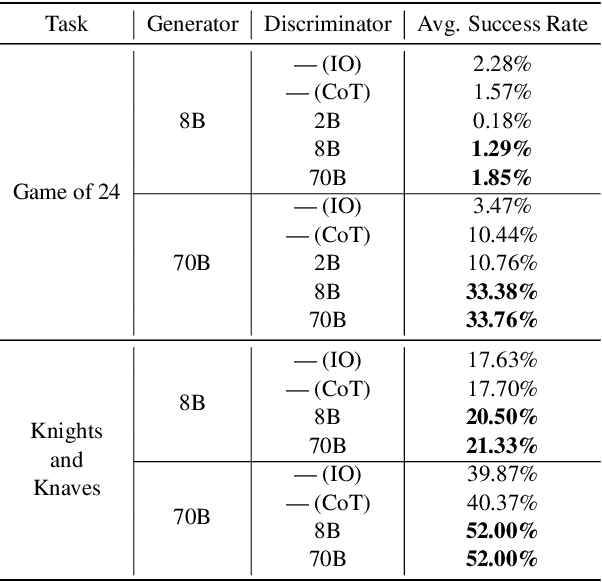

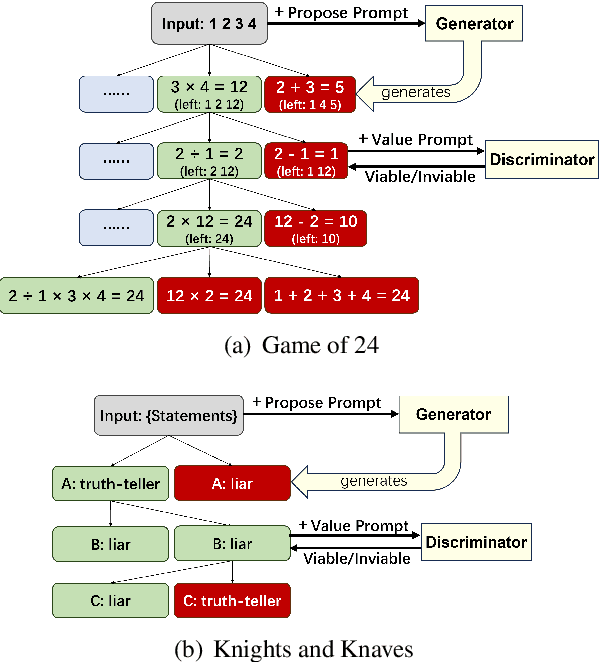
Abstract:Tree of Thoughts (ToT) is a reasoning strategy for Large Language Models (LLMs) that employs a generator to suggest reasoning steps and a discriminator to decide which steps to implement. ToT demonstrates strong performance on reasoning tasks, often surpassing simple methods such as Input-Output (IO) prompting and Chain-of-Thought (CoT) reasoning. However, ToT does not consistently outperform such simpler methods across all models, leaving large knowledge gaps on the conditions under which ToT is most beneficial. In this paper, we analyze the roles of the generator and discriminator separately to better understand the conditions when ToT is beneficial. We find that the generator plays a more critical role than the discriminator in driving the success of ToT. Scaling the generator leads to notable improvements in ToT performance, even when using a smaller model as the discriminator, whereas scaling the discriminator with a fixed generator yields only marginal gains. Our results show that models across different scales exhibit comparable discrimination capabilities, yet differ significantly in their generative performance for ToT.
 Add to Chrome
Add to Chrome Add to Firefox
Add to Firefox Add to Edge
Add to Edge